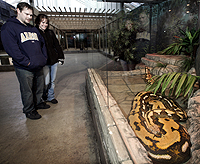
January 28, 2008

Attention to Chad Arment’s newest book, Boss Snakes: Stories and Sightings of Giant Snakes in North America will be worth your time.
First, let’s start with the obvious.
Big snakes do exist. But various cryptozoological questions remain: Are there unknown species? How big do they get? And where are they found?

Fluffy, above, who is thought to be the longest captive snake in the world at 24 feet long, drew record fans (1.53 million) to the Columbus Zoo and Aquarium in 2007. The reticulated python is 15 years old and weighs 300 pounds. It will keep growing, and may live to be 50 years or older. But, it’s a known species, of course.

Other beautiful snakes, such as this partially albino python, give more attention to the displaying of huge reptiles, as well. Big snakes are hard to ignore.

Ian Stewart, left, and Carrie Hoover visit Fluffy at Columbus Zoo. Can you imagine how popular the discovery of a giant unknown species would be?
There is no doubt that giant snakes are engaging and interesting. But are there truly giant snakes? And do they haunt North America?
Boss Snakes is one of the more intriguing cryptid-specific volumes of the year. Giant snake reports and sightings involve many levels of cryptozoology ~ actual unknowns, misidentifications, known species, eyewitness mistakes, folklore, archival news accounts, and escaped pets.
I like to read books by people that obviously enjoy what they are writing about, and Chad Arment shows that he likes and appreciates reptiles. He’s a herper, that’s apparent. But, I had to ask him, what kind of snakes does he keep.
He answered that while he owns “no giant snakes, unfortunately,…I do have about a dozen snakes. Some native species (various ratsnakes, coachwhips, western hognose, mole kingsnake), a six or seven foot boa, and some South American rearfangs (false water cobra and a couple others).”
I think that personal experience with snakes shows in his book. His newest volume appears well-suited to his special skills and passion.
Readers who wish to be taken aback by the title of the book are missing a chance to grasp where this book takes one within its pages.
In Arment’s introduction, he says precisely: “You won’t find a boss snake in your herpetological field guide….That is a name, about a century in disuse, for any large snake that dwarfed its scaly brethren. The possibility that such snakes might exist today should be examined critically and carefully, without dubious argumentation, but examined nonetheless,” (p. 11).
Arment is a scholarly researcher, who has done his chores and craft laboriously to create this work. For those interested in long passages on theories about what each giant snake encounter might mean, or a classification system dividing sightings into what snakes might fit with what accounts, this is not the book for you. But for casual fans of giant snakes, followers of cryptid wonders, and detailed researchers of large unknown snakes, this book will be a treasure trove of information that you will be devouring for years.
The book is a virtual file folder of every historical case that Arment seems to have been able to gather, reproduce, and share in its completeness, for your perusal and investigation.

Above: The back cover of Boss Snakes.
The tome’s “broad view” thoughts, certainly, are presented in the introduction, and Arment’s framing comes to an apex, I found, in his chapter three, “The Potential for Unknown Species.” Meanwhile, he skeptically dwells on sample cases, for starters in “Hoaxes, Tall Tales, and Paranormalism,” in his first chapter.
In his largest self-authored section, Chad Arment allows himself to stretch his legs and gives good insights on “Known Species: Native and Exotic Snakes” in chapter two.
What I am saying, in essence, is that if you are looking to read Chad Arment’s own thoughts and words, you will find, like in his The Historical Bigfoot (Coachwhip Publications, 2006), he has allowed the unedited data to do most of the talking. But that is not a shortcoming of this book; it is its strength.
The majority of Arment’s giant snakes book, especially in the text between pages 77 and 384, is filled with article after article, carefully divided by location (state or province) and reproduced without commentary. Arment splits his two great sections between “Giant Snakes” and what he sees as a vastly different natural grouping, “Giant Rattlesnakes.” It works.
Arment’s volume is an amazing resource guide showing individual maps of each state and province, with indicators of from where each of the giant reptilian reports issue, and via two overview maps as well, such as this one:

This is one of Arment’s Boss Snakes maps that plots the localities of alleged sightings of Giant Snakes (8+ feet in length). The book’s other United States map details the Giant Rattlesnake sighting locales.
In addition to those two maps, I counted 52 individual maps of states and provinces, and seven USA range maps of known larger species. The book also contains over 25 photographs and drawings of snakes.
Boss Snakes: Stories and Sightings of Giant Snakes in North America, at 389 pages, pound for pound, lives up to its name, and I recommend it for your cryptozoological collection. If you want to learn more about the historical giant snake accounts from North America, and place them in the context of the known, the overblown, and the unknown, you can’t go wrong with Chad Arment’s book.
I predict it will become the cornerstone reference work for all future treatments, theories, and thoughts about cryptid giant snakes in North America.
About Loren Coleman
Loren Coleman is one of the world’s leading cryptozoologists, some say “the” leading living cryptozoologist. Certainly, he is acknowledged as the current living American researcher and writer who has most popularized cryptozoology in the late 20th and early 21st centuries.
Starting his fieldwork and investigations in 1960, after traveling and trekking extensively in pursuit of cryptozoological mysteries, Coleman began writing to share his experiences in 1969. An honorary member of Ivan T. Sanderson’s Society for the Investigation of the Unexplained in the 1970s, Coleman has been bestowed with similar honorary memberships of the North Idaho College Cryptozoology Club in 1983, and in subsequent years, that of the British Columbia Scientific Cryptozoology Club, CryptoSafari International, and other international organizations. He was also a Life Member and Benefactor of the International Society of Cryptozoology (now-defunct).
Loren Coleman’s daily blog, as a member of the Cryptomundo Team, served as an ongoing avenue of communication for the ever-growing body of cryptozoo news from 2005 through 2013. He returned as an infrequent contributor beginning Halloween week of 2015.
Coleman is the founder in 2003, and current director of the International Cryptozoology Museum in Portland, Maine.
Filed under Books, Breaking News, Cryptomundo Exclusive, Cryptotourism, CryptoZoo News, Cryptozoologists, Cryptozoology, Evidence, Eyewitness Accounts, Folklore, Forensic Science, Out of Place, Photos, Reviews, Swamp Monsters